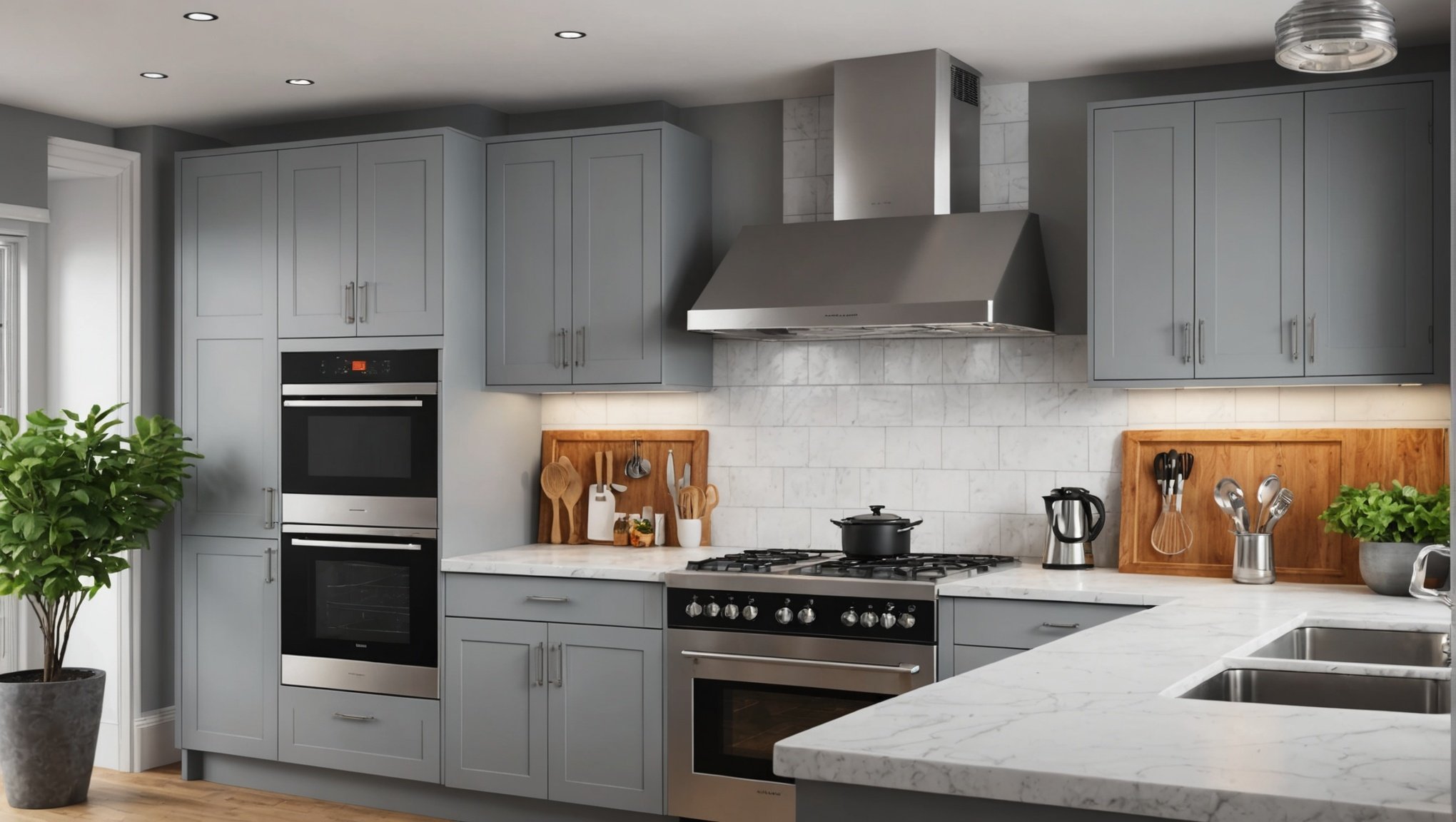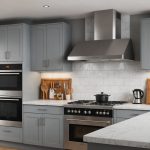A Step-by-Step Guide to Installing a Top-Notch Kitchen Ventilation System in Your UK Home
Why Kitchen Ventilation is Crucial
When it comes to your kitchen, ensuring proper ventilation is not just a matter of comfort; it’s a necessity for safety and health. A well-designed kitchen ventilation system can remove harmful fumes, reduce moisture, and prevent the buildup of grease and dust. Here’s why you need a top-notch kitchen ventilation system:
- Safety First: A kitchen without adequate ventilation can lead to the accumulation of carbon monoxide, nitrogen dioxide, and other harmful gases emitted by cookers and ovens. This can be particularly dangerous in enclosed spaces.
- Comfort and Health: Proper ventilation helps in maintaining a clean and healthy environment by removing cooking odors, moisture, and airborne particles.
- Kitchen Longevity: Good ventilation prevents grease and dust from settling on your kitchen surfaces, extending the lifespan of your appliances and furniture.
Choosing the Right Ventilation System
Selecting the right ventilation system for your kitchen involves several key considerations. Here are some steps to help you make the best choice:
In parallel : Essential Tips for Keeping Your Wooden Kitchen Cabinets Pristine in the UK
Assess Your Kitchen Space
Before you start shopping for a ventilation system, it’s essential to assess your kitchen space. Consider the size of your kitchen, the type of cooking you do most often, and the layout of your appliances.
- Kitchen Size: The size of your kitchen will determine the capacity of the ventilation system you need. Larger kitchens require more powerful extractors.
- Cooking Type: If you frequently use high-heat cooking methods or cook oily foods, you’ll need a system that can handle heavy-duty ventilation.
- Appliance Layout: Ensure the ventilation system is compatible with your cooker hood and other appliances.
Types of Ventilation Systems
There are several types of ventilation systems available, each with its own advantages and disadvantages.
Topic to read : Selecting the Perfect Kitchen Faucet for Your Contemporary UK Home: A Complete Guide
- Extractor Fans: These are the most common type of ventilation system for home kitchens. They are relatively inexpensive and easy to install.
- Pros: Affordable, easy installation, effective for small to medium-sized kitchens.
- Cons: May not be as powerful as commercial-grade systems, can be noisy.
- Commercial Kitchen Hoods: While typically used in commercial settings, these can also be installed in large home kitchens.
- Pros: Highly powerful, effective for heavy-duty cooking, can be customized.
- Cons: Expensive, complex installation, may require professional services.
Factors to Consider in Your Design Installation
When designing your kitchen ventilation system, several factors need to be considered to ensure you get the best results.
- Air Flow Rate: The ventilation rate depends on the size of your kitchen and the type of cooking. A general rule of thumb is to ensure the system can exchange the air in your kitchen at least 10 times per hour.
- Noise Level: If you plan to use your kitchen during early morning or late evening hours, consider a system with a low noise level.
- Additional Features: Some systems come with additional features like filters, lights, and timers. Determine which features are essential for your needs.
Step-by-Step Installation Guide
Installing a kitchen ventilation system can be a DIY project, but it often requires professional expertise, especially for more complex systems. Here’s a step-by-step guide to help you through the process:
Step 1: Plan Your Installation
- Consult Professionals: If you’re not experienced in DIY projects, it’s advisable to consult with professionals who specialize in kitchen extraction and ventilation solutions.
- Check Local Regulations: Ensure your installation complies with local building codes and regulations.
Step 2: Choose Your Equipment
- Extractor Fan or Hood: Based on your assessment, choose the right type of ventilation system. For example, if you have a small kitchen, an extractor fan might be sufficient. For larger kitchens or heavy-duty cooking, a commercial kitchen hood might be necessary.
- Accessories: Decide on any additional accessories you need, such as filters, lights, or timers.
Step 3: Prepare Your Space
- Clear the Area: Ensure the area around your cooker is clear of any obstructions.
- Measure and Mark: Measure the space where the ventilation system will be installed and mark it accordingly.
Step 4: Install the Ventilation System
- Extractor Fans:
- Mount the fan to the wall or ceiling according to the manufacturer’s instructions.
- Connect the ductwork to the fan and ensure it is securely fastened to the wall or ceiling.
- Connect the electrical wiring, ensuring all connections are safe and secure.
- Commercial Kitchen Hoods:
- This typically requires professional installation due to the complexity and size of the system.
- Ensure the hood is installed above the cooker at the recommended height.
- Connect the ductwork and electrical wiring, and test the system to ensure it is working correctly.
Cost Considerations
The cost of installing a kitchen ventilation system can vary widely depending on several factors.
Factors Affecting Cost
- System Type: Commercial kitchen hoods are generally more expensive than extractor fans.
- Installation Complexity: More complex installations, such as those requiring ductwork through walls or ceilings, can increase costs.
- Additional Features: Systems with additional features like filters, lights, and timers can be more expensive.
Estimated Costs
Here is a rough estimate of the costs involved:
| System Type | Unit Price Range | Installation Cost Range |
|---|---|---|
| Extractor Fan | £50 – £200 | £100 – £300 |
| Commercial Kitchen Hood | £500 – £2,000 | £500 – £2,000 |
Ensuring High Quality and Excellence
To ensure your kitchen ventilation system is of high quality and functions optimally, here are some tips:
Choose Reputable Subcontractors
If you decide to hire professionals for the installation, make sure to choose reputable subcontractors with experience in kitchen extraction and ventilation solutions.
Regular Maintenance
Regular maintenance is crucial to ensure your ventilation system continues to function effectively.
- Clean Filters: Clean or replace filters regularly to maintain airflow efficiency.
- Check Ductwork: Ensure ductwork is clear of obstructions and damage.
- Test the System: Periodically test the system to ensure it is working correctly.
Practical Insights and Actionable Advice
Here are some practical insights and actionable advice to help you through the process:
Example: Fan Extract Ltd
Companies like Fan Extract Ltd, which specialize in commercial kitchen extraction and ventilation solutions, can provide comprehensive services including planning, design, installation, supply, repair, and maintenance. They have extensive experience serving various types of kitchens, from cafes and hotels to public sector establishments.
Tips for DIY Installations
- Follow Manufacturer Instructions: Always follow the manufacturer’s instructions for installation to ensure safety and effectiveness.
- Use Proper Tools: Use the right tools for the job to avoid damaging the system or injuring yourself.
- Test Thoroughly: Test the system thoroughly after installation to ensure it is working correctly.
Installing a top-notch kitchen ventilation system is a significant investment in your home, but it is crucial for safety, comfort, and the overall health of your kitchen. By following these steps, considering the right factors, and ensuring high-quality installation and maintenance, you can create a kitchen that is not only functional but also safe and comfortable.
Additional Resources
For more detailed information on calculating ventilation rates, consult resources that provide comprehensive guides on kitchen ventilation. Here is an example of what you might need to consider:
Calculating Ventilation Rates
To calculate the right ventilation rate for your kitchen, you need to consider several factors:
- Kitchen Size: The larger the kitchen, the higher the ventilation rate needed.
- Cooking Type: Different types of cooking require different ventilation rates. For example, high-heat cooking requires more powerful ventilation.
- Appliance Type: The type of appliances you use also affects the ventilation rate. For instance, commercial-grade appliances may require higher ventilation rates.
Here is a simplified example of how you might calculate the ventilation rate:
| Kitchen Size (m²) | Cooking Type | Recommended Ventilation Rate (m³/h) |
|---|---|---|
| Small (10-20 m²) | Light Cooking | 300-500 m³/h |
| Medium (20-40 m²) | Medium Cooking | 500-800 m³/h |
| Large (40+ m²) | Heavy Cooking | 800-1200 m³/h |
Final Thoughts
In conclusion, installing a top-notch kitchen ventilation system is a critical aspect of maintaining a safe, comfortable, and healthy kitchen environment. By carefully planning, choosing the right equipment, and ensuring proper installation and maintenance, you can enjoy a kitchen that not only functions well but also enhances your overall cooking experience.
As a homeowner, it’s important to remember that a good ventilation system is not just an accessory but a necessity. Here’s what a professional from Fan Extract Ltd might say:
“Proper installation helps prevent safety issues and ensures your kitchen runs efficiently. A professional company will also guide you on the best hood for your needs, ensuring you get the high-quality results you deserve at reasonable prices.”
By following this guide and seeking advice from reputable professionals, you can ensure your kitchen ventilation system meets the highest standards of quality and performance.







No responses yet